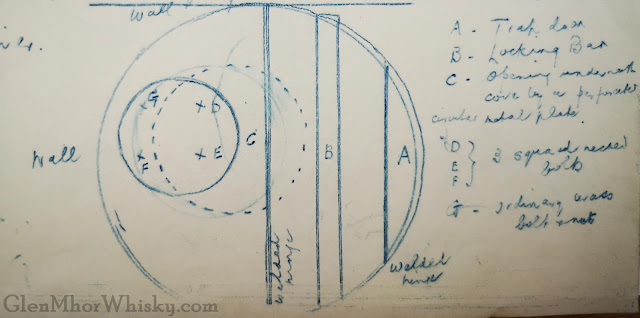Glen Mhor Log Book 7th July 1939
This is a rather unique entry, dated 7th July 1939 and comes a couple of months after the request for additional work at Glen Mhor, which you can see via the 29th June 1939 article and I'd recommend reading these in tandem.
The June record noted that the aforementioned work, would be assessed once completed. The page after this entry I believe - and noted below - forms the major part of this request and is a detailed report from a surveyor on the detail and quality of the work performed at Glen Mhor.
It is fascinating from a level of bureaucracy, showcasing the complete control and cataloguing of every element of production that could be tampered with and harnessed by individuals out to defraud the government. Right down to the types of nuts and bolts utilised, literally...
'B.O. 38398
7/7/1939
The proposed alterations to no's 1 and 2 Low Wine Stills should be provisionally approved on condition that the syphon pipe (no.2 LWS) and the discharge pipe (no.1 LWS) are connected and secured to the satisfaction of the Commissioners.
The Surveyor should report on the traders appreciation for final approval on completion of the alterations.
C.P. Allen
Approved as submitter above
1. A/Coll Ins to note for action accordingly.
2. BF with FC or in 3 ???'
Next page:
The syphon and air pipe has been transferred from the discharge of no.1 Low Wine Still to no.2 Low Wine Still, and inserted between the flange of the discharge cock and no.2 Spent Lees Receiver and securely fixed thereto by bolts effectively riveted over nuts to the flange joint of the turning cock; and to the top of the Spent Lees Receiver by 3 square headed and square necked brass bolts (D.E.F.) inserted from above and tightened by screwing nuts on the threat tails of the bolts, inside the Spent Lees. The 4th bolt (G) is an ordinary brass bolt, inserted from underneath with hexagonal nut screwed on top.
The 3 nuts (D.E.F.) cannot be reached through the trap door, when the cover is locked.
It is impossible to use a square necked bolt for the 4th or to rivet an ordinary bolt on account of its inaccessibility.
By the method adopted the syphon is securely fixed to the Spent Lees Receiver.'
Quite a thorough report you'll agree, as requested via the original approval, but this is indicative of what we're seeing throughout the Customs & Excise records. What the records underline is that the original Low Wines Still was still connected and viable to the production network. For whatever reason, it was deemed unnecessary to bring it back online, instead favouring the above work, which in effect, left this original still excised and isolated from the distillery.
Why the haste and need to do this? Well, I believe that the original Low Wine Still was still viable. We know from the logbook, the new manager wanted to test it earlier in the year. While we don't have anything to outline the outcome of the test, it seems likely that it was successful. Instead, the following year, the piping as noted here, was removed and utilised elsewhere. One possible reason is a quick fix as it seems reasonable to swap like-for-like if you have a redundant still.
Plans from 1898, showcasing a variety of alterations at the distillery have been discovered. Many of these were not implemented immediately, but from this plan, and also the images from the Distilleries of Great Britain article from the 1920s, I believe this is the Stillroom set up:
Also, we have to remember the timeline, as this is on the eve of the Second World War. The UK government had been preparing since 1936 in terms of foodstuffs for the worst outcome, which was war. Scrap metal drives were just on the horizon and materials would have been scarce, controlled and potentially delayed. This economic and environmental climate likely motivated the team to use what they had on site.
Unless future pages from the logbook state otherwise, we can confidently say that whenever the Low Wines No.2 Still was installed - current working date of installation is 1925 - this ended the career of the No.1 Still. A move that was cemented with the excision of piping in this entry, 14 years later.



Comments
Post a Comment